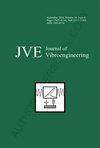A comprehensive review of mechanical fault diagnosis methods based on convolutional neural network
IF 0.9
Q4 ENGINEERING, MECHANICAL
引用次数: 0
Abstract
Mechanical fault diagnosis can prevent the deterioration of mechanical equipment failures and is important for the stable operation of mechanical equipment. Firstly, this paper reviews three basic methods of fault diagnosis and common methods of data-driven fault diagnosis, focusing on the characteristics and advantages of deep learning and convolutional neural networks. Then, the basic structure and working principle of CNN (Convolutional Neural Networks) and some basic methods to achieve better training results are introduced. In the next place, from data processing, data fusion, sample set construction, and so on, it is reviewed that the method of fault diagnosis based on CNN and their application scenarios and advantages and disadvantages; for another, the related knowledge and concepts of transfer learning are introduced, and some current application scenarios and advantages and disadvantages of mechanical fault diagnosis techniques combining migration learning and convolutional neural networks are reviewed. Finally, the current difficulties and challenges of convolutional neural networks are discussed, and the research directions have been prospected for CNN applied to the field of fault diagnosis. Although there is quite some similar literature reviewed, this review aims to introduce the basic methods of fault diagnosis, which draw forth the basic applications of the fault diagnosis of data-driven, CNN in the domain of fault diagnosis, and the application scenarios and advantages and disadvantages of combining TL (Transfer Learning) and CNN in fault diagnosis, as well as some problems and prospects. It helps researchers to have a basic understanding of this.基于卷积神经网络的机械故障诊断方法综述
机械故障诊断可以防止机械设备故障的恶化,对机械设备的稳定运行具有重要意义。本文首先综述了故障诊断的三种基本方法和数据驱动故障诊断的常用方法,重点介绍了深度学习和卷积神经网络的特点和优势。然后介绍了CNN(卷积神经网络)的基本结构和工作原理,以及达到较好训练效果的一些基本方法。其次,从数据处理、数据融合、样本集构建等方面综述了基于CNN的故障诊断方法及其应用场景和优缺点;另一方面,介绍了迁移学习的相关知识和概念,综述了迁移学习与卷积神经网络相结合的机械故障诊断技术的一些应用场景和优缺点。最后,讨论了卷积神经网络目前面临的困难和挑战,展望了卷积神经网络应用于故障诊断领域的研究方向。虽然已有不少类似的文献综述,但本文旨在介绍故障诊断的基本方法,提出数据驱动、CNN在故障诊断领域的基本应用,以及迁移学习(Transfer Learning)和CNN在故障诊断中的应用场景和优缺点,以及存在的问题和展望。它有助于研究人员对此有一个基本的了解。
本文章由计算机程序翻译,如有差异,请以英文原文为准。
求助全文
约1分钟内获得全文
求助全文
来源期刊

Journal of Vibroengineering
工程技术-工程:机械
CiteScore
1.70
自引率
0.00%
发文量
97
审稿时长
4.5 months
期刊介绍:
Journal of VIBROENGINEERING (JVE) ISSN 1392-8716 is a prestigious peer reviewed International Journal specializing in theoretical and practical aspects of Vibration Engineering. It is indexed in ESCI and other major databases. Published every 1.5 months (8 times yearly), the journal attracts attention from the International Engineering Community.
 求助内容:
求助内容: 应助结果提醒方式:
应助结果提醒方式:


